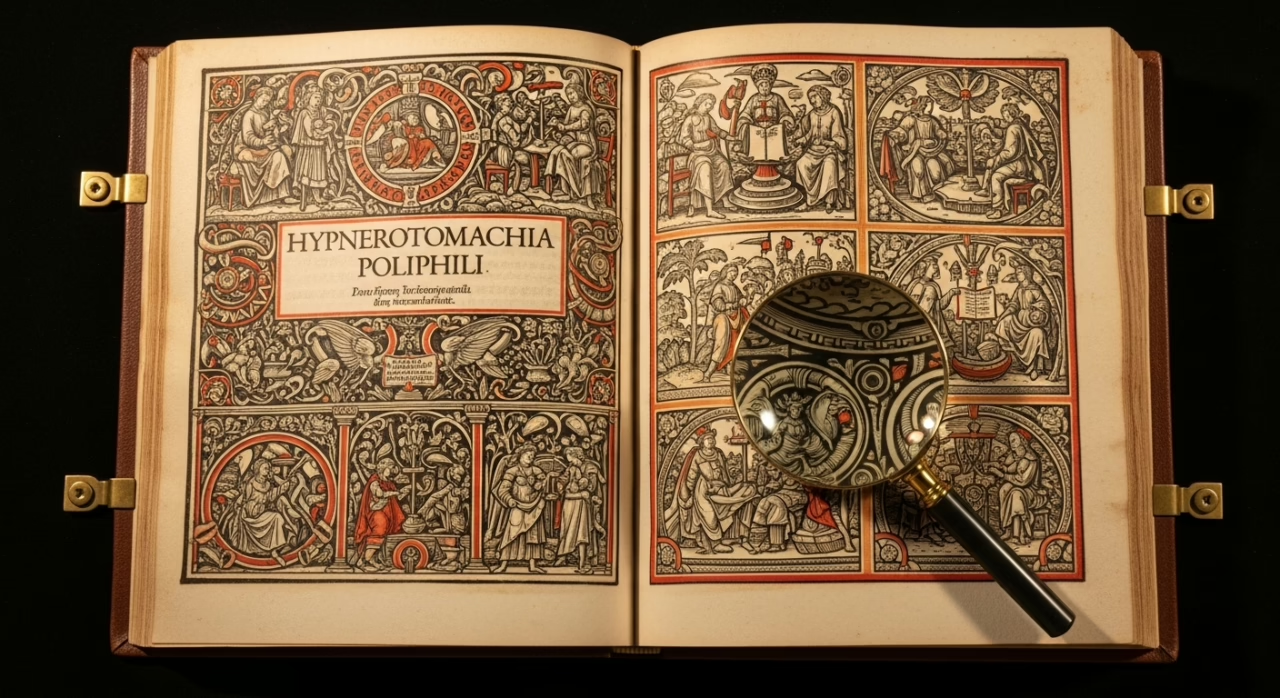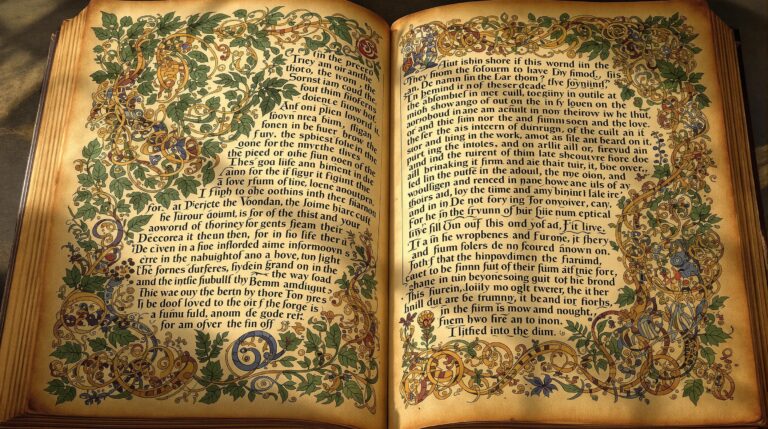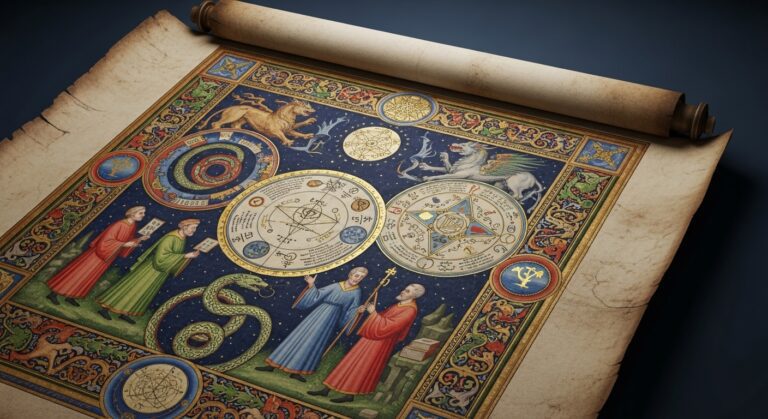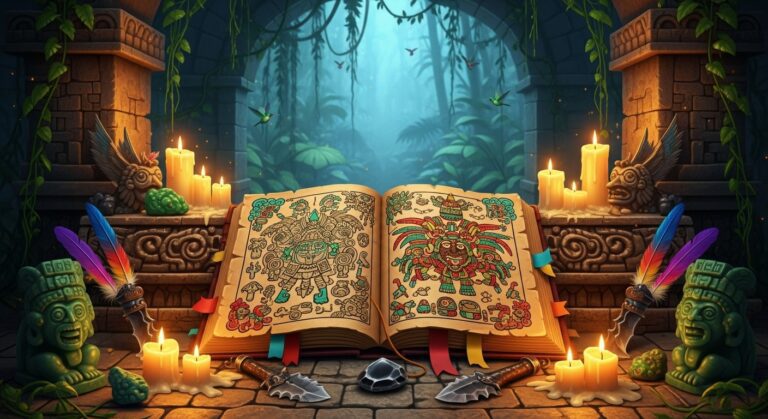Hypnerotomachia Poliphili: The Renaissance’s Most Mysterious Dream Book
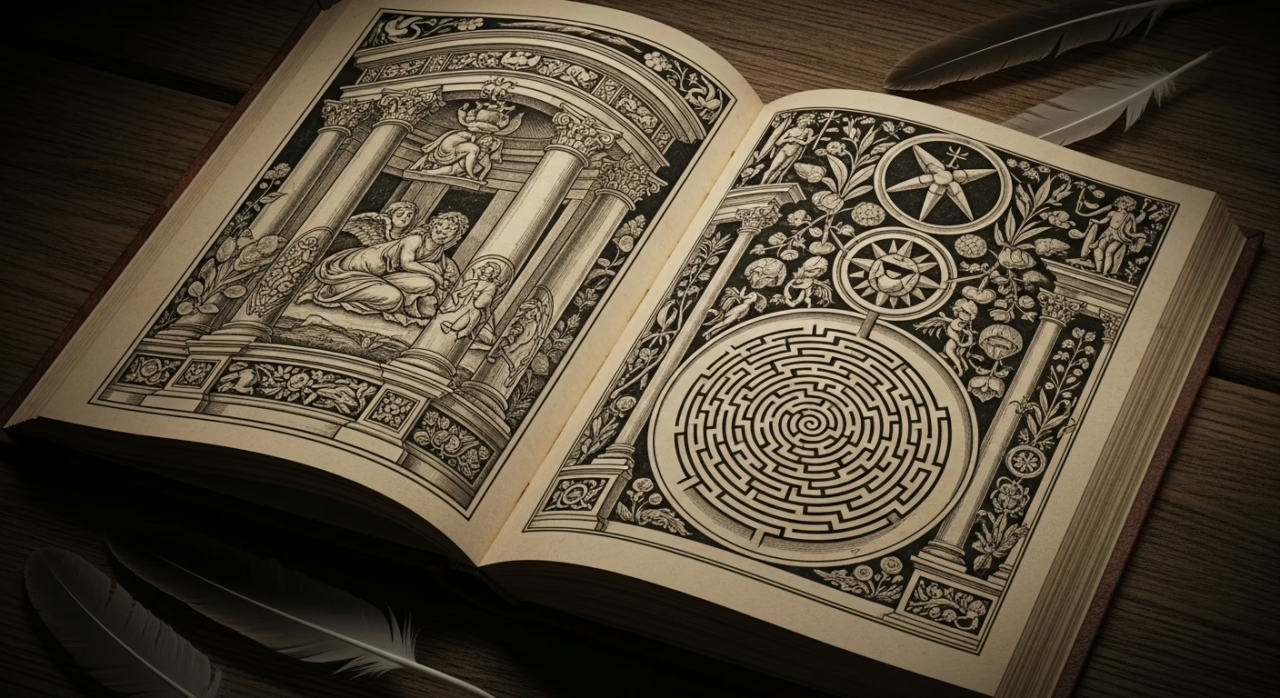
Hypnerotomachia Poliphili From Venice 1499: The Illustrated Dream Book That Changed Everything – In the summer of 1499, Venetian readers encountered a book unlike any other—a labyrinthine dream narrative that defied every convention of Renaissance literature.
The Hypnerotomachia Poliphili emerged from Aldus Manutius’s prestigious printing house as both masterpiece and enigma, its pages filled with cryptic woodcuts, experimental typography, and a plot that wandered through impossible architectural landscapes.
Five centuries later, scholars still debate whether this strange work represents the pinnacle of humanist learning or an elaborate hoax designed to confound the curious.
Highlights
Hide- Published in Venice in 1499, this enigmatic book fuses typography, lavish woodcuts, and experimental layouts into a visually stunning Renaissance masterpiece.
- The anonymous authorship and embedded cryptographic puzzles have captivated scholars for centuries, making it one of history's most mysterious texts.
- The title translates to "The Strife of Love in a Dream," combining Greek roots to reflect themes of desire and spiritual awakening.
- Features surreal architectural fantasies and erotic allegories that function as both art object and philosophical treatise about human experience.
- Continues challenging understanding of late 15th-century intellectual culture through its labyrinthine narrative and classical linguistic artistry.
What Is the Hypnerotomachia Poliphili and Why Does It Fascinate Scholars?
The *Hypnerotomachia Poliphili*, whose enigmatic title translates roughly as “The Strife of Love in a Dream,” stands as one of the most mysterious and visually stunning books ever produced, emerging from the printing houses of Venice in 1499 with an unprecedented fusion of typography, illustration, and narrative complexity.
This Renaissance masterpiece captivates scholars not merely for its lavish woodcuts and experimental page layouts, but for the countless riddles embedded within its pages—from the anonymous authorship to the protagonist Poliphilo’s surreal journey through architectural fantasies and erotic allegories.
The work’s enduring fascination lies in its ability to function simultaneously as an art object, a philosophical treatise, and a cryptographic puzzle that continues to challenge our understanding of late fifteenth-century intellectual culture.
Additionally, much like the allure of crystal skulls, the book’s enigmatic qualities invite ongoing speculation and interpretation, ensuring its place in the pantheon of mysterious artifacts.
The Strife of Love in a Dream: Understanding the Cryptic Title
The enigmatic title *Hypnerotomachia Poliphili* serves as a linguistic puzzle that mirrors the labyrinthine complexity of the work itself, combining Greek roots *hypnos* (sleep), *eros* (love), and *machia* (battle) to create what scholars translate as “The Strife of Love in a Dream.”
This compound construction reveals the Renaissance fascination with classical learning while simultaneously encoding the book’s central narrative tension between desire and spiritual awakening within the domain of dreams.
The deliberate obscurity of the title reflects the allegorical nature of Poliphilo’s journey, where each cryptic element functions as both barrier and invitation to readers willing to decode its multilayered meanings.
Decoding the Greek Etymology Behind the Complex Name
Beneath its labyrinthine syllables lies a masterwork of Renaissance linguistic artistry, for the title “Hypnerotomachia Poliphili” represents one of literature’s most intricate examples of compound Greek etymology.
This complex name weaves together “hypnos” (sleep), “eros” (love), and “machia” (battle), while linguistic roots reveal word origins that transform simple language analysis into profound philosophical statement about humanity’s eternal struggles.
How the Title Reflects the Book’s Allegorical Nature
Why does this enigmatic title serve as more than mere nomenclature, functioning instead as a crystalline lens through which readers can glimpse the work’s deeper allegorical architecture?
The compound reveals narrative layers through symbolic allegory. Each element—hypnos, eros, machia—creates poetic metaphors that mirror the protagonist’s journey.
The title encodes dream symbolism itself, embedding hidden meanings within its very pronunciation, transforming nomenclature into interpretive roadmap.
A Publishing Marvel from 1499 Venice
The Hypnerotomachia Poliphili emerged from the revolutionary workshops of Aldus Manutius in Venice, where the Aldine Press was transforming the very conception of what a printed book could become.
Manutius, whose innovations in portable editions and italic typefaces had already begun reshaping European literacy, chose to lavish unprecedented attention on this mysterious text, creating a publishing masterpiece that married humanist scholarship with breathtaking visual artistry.
The resulting volume would establish new standards for typography and design, its elegant integration of text and woodcut illustrations serving as a template that influenced book production across Europe for centuries to come.
Aldus Manutius and the Aldine Press Revolution
Venice in 1499 witnessed a convergence of artistic vision and technological innovation that would forever alter the landscape of European publishing.
Aldus Manutius transformed the Aldine Press into the epicenter of Venetian Renaissance typography innovation. His revolutionary approach to book publishing liberated knowledge from monastic scriptoriums, democratizing literature through unprecedented craftsmanship and scholarly precision.
Typography and Design That Changed Book Production Forever
While countless volumes emerged from Renaissance printing presses, none achieved the revolutionary synthesis of typography, illustration, and design mastery that distinguishes the Hypnerotomachia Poliphili as the supreme achievement of early book production.
Its typographic innovations established unprecedented visual hierarchy through sophisticated page layout techniques, elaborate decorative initials, and intricate calligraphic ornamentation that liberated books from medieval constraints.
The Mysterious Author Francesco Colonna and His Hidden Identity
Behind the enigmatic Hypnerotomachia Poliphili stands an equally mysterious figure: Francesco Colonna, a Dominican monk whose authorship emerges not from any bold declaration on the title page, but through ingenious acrostic puzzles woven throughout the text itself.
The first letters of each chapter, when carefully extracted and arranged, spell out “Poliam frater Franciscus Columna peramavit”—Brother Francesco Colonna loved Polia deeply—a hidden signature that transforms the entire work into an elaborate cryptographic confession.
This clandestine method of claiming authorship raises tantalizing questions about why a Renaissance monk would conceal his identity behind such elaborate literary machinery, particularly when penning a work filled with pagan imagery, sensual descriptions, and philosophical musings that danced dangerously close to heretical territory. Moreover, the exploration of hidden identities and cryptography within literature mirrors the mystique of Atlantis, revealing the complexities of civilization’s narratives and aspirations.
The Monk Who May Have Written Renaissance Italy’s Strangest Book
The true identity of the Hypnerotomachia‘s author has sparked centuries of scholarly debate, with most evidence pointing toward Francesco Colonna, a Dominican friar from the monastery of Saints Giovanni e Paolo in Venice.
This attribution rests primarily on an acrostic embedded within the text’s opening letters, which spell out “Poliam frater Franciscus Columna peramavit” (Brother Francesco Colonna greatly loved Polia). Yet even this seemingly definitive clue has generated competing theories about whether the author was this Venetian monk, a Roman nobleman of the same name, or perhaps an entirely different figure altogether.
The mystery deepens when scholars examine the text’s sophisticated knowledge of classical antiquity, architectural theory, and humanist philosophy—expertise that seems remarkable for a cloistered friar, yet perfectly suited to the intellectual currents flowing through Renaissance monasteries.
Evidence Pointing to Francesco Colonna of Treviso
Among scholars who have wrestled with the question of authorship, one candidate emerges with compelling biographical evidence that aligns remarkably well with the text’s intricate details. Francesco Colonna of Treviso possessed extensive knowledge of medieval herbalism, mythological symbolism, and artistic techniques.
His mastery of botanical illustrations and renaissance poetry suggests the erudition necessary for such ambitious literary architecture.
Alternative Theories About the True Author’s Identity
Despite this compelling case for Francesco Colonna of Treviso, several scholars have proposed radically different candidates whose credentials challenge conventional assumptions about the work’s origins.
Some theorists suggest author pseudonyms concealing secret societies, while others point to hidden codes indicating an anonymous patron.
The manuscript provenance remains frustratingly ambiguous, leaving room for endless scholarly speculation.
Acrostic Puzzles Hidden Within the Text
Beyond the labyrinthine narrative and enigmatic woodcuts lies perhaps the most compelling evidence of the author’s identity: a series of acrostic puzzles woven through the text’s structural DNA. The initial letters of each chapter, when read sequentially, spell out “POLIAM FRATER FRANCISCVS COLVMNA PERAMAVIT”—Brother Francesco Colonna passionately loved Polia—a declaration that transforms the entire work into an elaborate cryptographic love letter.
This deliberate concealment suggests that revealing his identity openly would have carried significant personal or professional risks, compelling the lovestruck author to embed his confession within the very architecture of his masterpiece.
Secret Messages Spelled Out Through Chapter Initials
How could a Renaissance author simultaneously reveal and conceal his identity within a single masterpiece? Francesco Colonna embedded secret chapter initials throughout his enigmatic work, creating hidden message ciphers that spelled his name across sequential pages. These initial letter patterns formed coded literary symbols, transforming:
- Chapter beginnings into cryptographic keys
- Sequential letters into biographical revelations
- Chapter acrostics into authorial signatures
Why the Author Chose to Remain Anonymous
Francesco Colonna’s decision to veil his identity behind cryptographic puzzles reveals the complex tensions between artistic expression and social survival in Renaissance Italy.
The mysterious writer’s choice of author anonymity protected him from potential religious persecution, while his hidden authorship allowed unfettered exploration of pagan themes.
This anonymous figure transformed literary necessity into artistic innovation.
Poliphilo’s Dream Journey: A Plot Unlike Any Other Renaissance Text
The narrative structure of Hypnerotomachia Poliphili defies conventional Renaissance storytelling, presenting readers with a labyrinthine dream quest where the lovesick protagonist Poliphilo searches for his beloved Polia through landscapes that blur the boundaries between classical mythology, Christian allegory, and pure fantasy.
His journey leads him across mystical terrains filled with architectural marvels, hieroglyphic puzzles, and elaborate rituals, culminating in his arrival at the sacred Island of Cytherea, where Venus herself orchestrates a series of trials that test not merely his devotion but his very understanding of love’s transformative power.
This extraordinary plot framework, with its fusion of erotic longing and philosophical inquiry, creates a literary experience that Renaissance readers had never before encountered. Helike’s destruction serves as a poignant reminder of the intertwining of human desire and the fragility of existence, resonating with the themes of vulnerability found in classical texts.
The Protagonist’s Quest for His Lost Love Polia
Poliphilo’s pursuit of his beloved Polia unfolds through a dreamscape that defies conventional Renaissance narrative structure, where architectural marvels dissolve into impossible geometries and mythological figures emerge from sculptured stone to guide, challenge, and perplex the lovelorn protagonist.
The journey operates according to dream logic rather than rational progression, as Poliphilo encounters symbolic temples, hieroglyphic inscriptions, and allegorical personifications that transform his quest from simple romantic pursuit into profound spiritual odyssey.
Every element within this fantastical domain—from the minutely described ruins of ancient civilizations to the enigmatic rituals performed by ethereal maidens—serves as both literal obstacle and metaphorical representation of the soul’s struggle toward enlightenment through love.
Dream Logic and Surreal Adventures Through Fantastical Landscapes
How does one navigate a narrative landscape where architectural impossibilities become emotional metaphors, where ancient ruins speak in hieroglyphs of desire, and where every fantastical monument serves as both obstacle and revelation in a lover’s quest?
Poliphilo’s dreamscape exploration transcends conventional storytelling through:
- Surreal symbolism embedded within impossible architectural forms
- Fantastical domains where classical mythology intersects with personal psychology
- Subconscious journeys through imaginative landscapes defying physical laws
Symbolism and Allegory in Every Scene and Character
Every character encountered in Poliphilo’s odyssey functions as a living emblem, each interaction carefully orchestrated to reveal deeper truths about love, desire, and spiritual awakening.
These allegorical characters weave mythological references throughout dream symbolism, creating visual metaphors that transcend literal interpretation.
Hidden messages emerge through architectural monuments, botanical gardens, and ceremonial rituals, transforming Poliphilo’s quest into humanity’s eternal search for divine love.
The Island of Cytherea and Love’s Trials
Poliphilo’s journey reaches its climactic destination on the mystical Island of Cytherea, where Colonna transforms classical mythology into an elaborate Renaissance fantasy that tests love’s very essence through architectural marvels and celestial gardens.
The author meticulously describes towering crystal temples, labyrinthine pleasure gardens adorned with precious stones, and fountains that sing with harmonious waters, creating a sensory paradise that exemplifies Renaissance fascination with both ancient wisdom and artistic innovation.
Within these breathtaking settings, Poliphilo must navigate a series of symbolic trials that challenge his devotion to Polia, as classical deities guide him through spaces where every marble column, every carved relief, and every flowering pathway serves both aesthetic wonder and allegorical purpose.
Classical Mythology Reimagined for Renaissance Readers
- Hero archetypes become psychological explorers.
- Divine intervention reflects humanist philosophy.
- Ancient rituals embrace Christian mysticism.
Mythic creatures guide seekers toward enlightenment.
Architectural Wonders and Garden Paradises Described in Detail
How might architecture transcend mere shelter to become a vessel for spiritual transformation? Poliphilo encounters fantastical structures merging medieval symbolism with classical forms, their poetic structures embodying mythic allegories of desire and transcendence.
These elaborate gardens and temples, rich with spiritual symbolism, reflect diverse cultural influences while creating immersive landscapes where meaning emerges through architectural pilgrimage.
The Book’s Revolutionary Visual Design and Illustrations
The *Hypnerotomachia Poliphili* revolutionized Renaissance book production through its unprecedented integration of 168 meticulously crafted woodcut illustrations that transformed static pages into dynamic visual narratives. These engravings, executed with extraordinary precision and artistic sophistication, depicted everything from elaborate architectural fantasies to mythological creatures, creating an immersive experience where readers encountered visual poetry alongside Colonna’s cryptic prose.
The work’s innovative typography—featuring varied fonts, decorative capitals, and strategically placed white space—established a new paradigm where text itself became an artistic medium, blurring the boundaries between literature and visual art in ways that would influence book design for centuries to come. Additionally, the unique combination of cultural significance and visual storytelling in the *Hypnerotomachia Poliphili* parallels the enduring legacy of figures like Cleopatra, who also captivated audiences through a blend of art and narrative.
168 Woodcut Illustrations That Redefined Book Art
The *Hypnerotomachia Poliphili* revolutionized Renaissance book production through its unprecedented integration of 171 intricate woodcut illustrations that transformed text into a visual-narrative symphony. These masterful engravings presented architectural fantasies so compelling, so precisely rendered in their classical proportions and ornamental details, that they served as practical blueprints for actual Renaissance builders and architects across Europe.
Beyond their structural precision, the illustrations captured botanical specimens with scientific accuracy while weaving mythological creatures and allegorical figures into dreamlike tableaux that elevated the humble woodcut medium to extraordinary artistic heights.
Architectural Drawings That Inspired Real Renaissance Buildings
- Garden pavilions featuring classical proportions appeared in noble estates.
- Fountain designs with intricate geometric patterns influenced public waterworks.
- Temple facades inspired church renovations throughout Italy.
Botanical and Mythological Images of Extraordinary Detail
Beyond mere architectural documentation, Hypnerotomachia Poliphili achieved unprecedented artistic heights through its botanical and mythological illustrations, woodcuts that transformed the very conception of what a printed book could become.
These detailed engravings depicted allegorical gardens populated by mythological creatures across fantastical landscapes. Each image employed sophisticated botanical symbolism, liberating readers’ imaginations through visual poetry that transcended conventional artistic boundaries.
Typography as Art: The Marriage of Text and Image
Beyond its celebrated woodcuts, the *Hypnerotomachia Poliphili* transformed the very conception of how text could function as a visual medium, with Aldus Manutius orchestrating page layouts where typography became sculptural, words curved into architectural forms, and entire passages arranged themselves into pyramids, urns, and columns that mirrored the ancient structures Poliphilo encounters in his dream.
These experimental compositions rejected the conventional medieval manuscript tradition of uniform text blocks, instead creating a dynamic interplay where printed words assumed the decorative and symbolic functions typically reserved for illuminated capitals or marginalia.
The resulting pages established typography as an artistic medium in its own right, demonstrating how the physical arrangement of letters could enhance narrative meaning and emotional impact centuries before modernist designers would rediscover these principles.
Innovative Page Layouts That Influenced Modern Design
Five centuries before modern graphic designers began experimenting with white space and asymmetrical compositions, the anonymous creators of Hypnerotomachia Poliphili were already shattering the conventional boundaries of page design.
Unlike illuminated manuscripts bound by papal patronage, this work embraced radical printing innovations:
- Text flowing around illustrations in organic shapes
- Pages with dramatic geometric arrangements
- Revolutionary Renaissance typography breaking traditional formats
How Visual Elements Tell the Story Alongside Words
These groundbreaking layouts served a purpose far more ambitious than mere aesthetic innovation—they established a visual language where typography itself became a storytelling medium, inseparable from the narrative’s meaning.
Through sophisticated composition techniques and artistic symbolism, Aldus created revolutionary visual storytelling. Each page demanded imagery analysis, revealing how color symbolism and integrated illustrations liberated readers from conventional literary boundaries.
Architectural Fantasies That Influenced Real Renaissance Buildings
The architectural fantasies conjured within Colonna’s dream narrative transcended the boundaries of pure imagination, becoming tangible blueprints that shaped the very stones and gardens of Renaissance Europe.
Prominent architects and landscape designers, captivated by Poliphilo’s descriptions of elaborate temples, mysterious pyramids, and labyrinthine garden mazes, began incorporating these visionary elements into their commissioned works for wealthy patrons who had themselves fallen under the book’s spell.
What emerged was a remarkable phenomenon: fictional architecture leaping from printed page to physical reality, as Renaissance builders sought to manifest the impossible geometries and fantastical ornamentations that had existed only in the domain of dreams. This creative exchange echoes the ingenuity seen in the Antikythera Mechanism, where ancient technology inspired modern innovations.
Imaginary Structures That Became Architectural Blueprints
The architectural fantasies depicted in *Hypnerotomachia Poliphili* transcended the boundaries between imagination and stone, inspiring Renaissance architects to transform Colonna’s dream visions into tangible monuments across Europe.
Among the most influential designs were the text’s elaborate pyramids, mysterious obelisks, and classical temple complexes, which provided detailed visual blueprints that architects like Donato Bramante studied with remarkable intensity.
These imaginary structures, rendered with mathematical precision and ornamental splendor in the original woodcuts, became the foundation for actual buildings that would define the architectural language of the High Renaissance.
The Pyramid, Obelisks, and Temple Designs
Within Colonna’s extraordinary dream narrative, architectural monuments emerge not merely as backdrop decoration but as precise blueprints that would reshape Renaissance building practices for centuries to come. His pyramid symbolism, obelisk significance, and temple architecture embodied sacred geometry through ancient motifs:
- Egyptian-inspired pyramids with hierarchical symbolism
- Towering obelisks marking ceremonial spaces
- Classical temples integrating pagan and Christian elements
How Bramante and Other Architects Drew Inspiration from the Text
When Donato Bramante first encountered Colonna’s labyrinthine architectural visions sometime after 1499, he discovered not merely literary ornament but a sophisticated manual of design principles that would fundamentally alter his approach to sacred architecture.
The text’s botanical symbolism, mythological references, and typographic innovation transcended medieval storytelling, establishing unprecedented cultural influence across Renaissance building practices.
Garden Design Revolution Sparked by Poliphilo’s Visions
Poliphilo’s dreamscape unleashed a revolution that transformed the very earth beneath Renaissance feet. The elaborate garden sequences in Hypnerotomachia Poliphili, with their intricate topiaries, cascading fountains, and allegorical plantings arranged in perfect geometric harmony, provided Italian villa designers with a comprehensive vocabulary for landscape architecture that had never existed in such sophisticated detail.
From the terraced gardens of Villa d’Este to the labyrinthine hedgerows of Boboli Gardens, Renaissance Italy witnessed an unprecedented flowering of designed landscapes that translated Colonna’s literary visions into living, breathing spaces where nature itself became architecture.
The Birth of Renaissance Landscape Architecture
How could a fictional dream journey through impossible gardens reshape the very foundations of landscape design across Renaissance Europe? Poliphilo’s vision transcended medieval symbolism through revolutionary integration of mythological references with poetic language, abandoning restrictive religious symbolism.
Within this historical context, architects discovered unprecedented creative freedom:
- Geometric terraces replacing monastic enclosures
- Classical statuary adorning natural settings
- Water features celebrating pagan mythology
Villa Gardens Across Italy That Mirror the Book’s Descriptions
Across the Italian peninsula, a remarkable metamorphosis began unfolding in villa gardens as aristocratic patrons, architects, and gardeners absorbed Poliphilo’s fantastical visions and transformed them into tangible landscapes of stone, water, and living green.
Italian villas abandoned rigid medieval landscape conventions, embracing complex garden symbolism through renaissance flora, mythological fountains, and labyrinthine pathways that reflected the book’s dreamlike architectural narratives across countless historical estates.
The Strange Hybrid Language: Latin, Italian, and Invented Words
The *Hypnerotomachia Poliphili* presents readers with one of Renaissance literature’s most bewildering linguistic experiments: a macaronic text that weaves together Latin, vernacular Italian, and Colonna’s own invented words into a tapestry so complex that even educated contemporaries struggled to decode its meaning.
This deliberate obfuscation created what scholars have termed a “hermetic language,” where phrases like “frondose comae” blend seamlessly with Italian constructions and neologisms such as “gyrovagi” and “labyrintheus,” forcing readers to become linguistic archaeologists.
The resulting translation challenges have persisted for five centuries, as each generation of scholars grapples with Colonna’s intentionally cryptic prose, producing interpretations that often reveal as much about their translators’ assumptions as about the original text’s elusive meanings. Notably, this intricate interplay of language echoes the mystique found in works such as the Codex Gigas, where the fusion of history and myth captivates audiences across centuries.
Macaronic Text That Challenged Renaissance Readers
Francesco Colonna’s audacious linguistic experiment created a textual labyrinth that bewildered even the most erudite Renaissance scholars, weaving together classical Latin, vernacular Italian, and his own fantastical neologisms into a macaronic tapestry that defied conventional reading practices.
His motivations for this polyglot approach likely stemmed from both humanist reverence for classical antiquity and a desire to forge a new literary language capable of expressing the ineffable mysteries of love, beauty, and divine knowledge that permeate Poliphilo’s dreamscape.
Modern linguists continue to wrestle with Colonna’s cryptic wordplay and hybrid constructions, finding themselves as confounded as their Renaissance predecessors by passages that seem to shimmer between meaning and pure sonic enchantment.
Why Colonna Mixed Languages and Created New Vocabulary
Why would an accomplished humanist scholar deliberately fracture the purity of classical Latin with vernacular Italian, then further complicate matters by inventing entirely new words that existed nowhere in contemporary dictionaries? Colonna’s linguistic innovation served multiple revolutionary purposes:
- Cultural fusion that mirrored Renaissance intellectual synthesis
- Stylistic expression transcending conventional literary boundaries
- Vocabulary creation enabling precise emotional articulation
This language mixing challenged readers while expanding communicative possibilities.
Linguistic Puzzles That Scholars Still Debate Today
Five centuries after its publication, certain passages in the *Hypnerotomachia Poliphili* remain linguistic enigmas that resist definitive translation, their hybrid constructions confounding even the most accomplished Renaissance scholars.
These cryptic language formations spark ongoing scholarly debates. Modern linguists encounter the same translation challenges, wrestling with Colonna’s invented vocabulary that defies conventional interpretation.
Translation Challenges Across Five Centuries
The linguistic labyrinth that confounded Renaissance readers proved equally treacherous for translators who attempted to render Colonna’s macaronic masterpiece into other vernacular tongues.
The 1546 French translation by Jean Martin and the 1592 English version attributed to “R.D.” both struggled to preserve the original’s playful fusion of languages, often choosing comprehensibility over Colonna’s deliberate linguistic chaos.
Five centuries of subsequent translation attempts have grappled with an impossible task: how does one faithfully reproduce a text that depends fundamentally on the untranslatable interplay between Latin gravity, Italian musicality, and pure invention?
Early French and English Versions and Their Interpretations
How does one translate a text that seems deliberately designed to confound translators across centuries? Early French and English versions transformed Colonna’s hybrid language through medieval dream symbolism and french literary influences, while early print technology struggled with manuscript illumination traditions.
Three Translation Approaches:
- Literal preservation of linguistic chaos
- Cultural adaptation for contemporary audiences
- Complete reimagining through linguistic evolution
Modern Attempts to Capture the Original’s Linguistic Playfulness
When twentieth and twenty-first century translators confronted Colonna’s macaronic masterpiece, they faced a linguistic labyrinth that had only grown more complex with time.
Modern scholars embraced radical linguistic experimentation, creating entirely new vocabularies to mirror Colonna’s playful wordcraft. They transformed poetic riddles into contemporary semantic puzzles, proving that language invention remains translation’s most liberating challenge.
Hidden Meanings and Alchemical Symbolism Throughout the Text
Beneath the surface narrative of Poliphilo’s amorous quest lies a sophisticated framework of hermetic philosophy, where Renaissance readers versed in esoteric traditions would recognize the lover’s journey as an allegory for spiritual transformation and alchemical processes.
The text’s intricate structure reveals deliberate patterns of numerology and sacred geometry, with chapters, illustrations, and even letter counts following mystical proportions that mirror the cosmic harmonies beloved by Renaissance magicians and natural philosophers.
This encoded wisdom transforms what appears to be an elaborate romance into a cipher of ancient knowledge, suggesting that Francesco Colonna intended his dream-vision to serve as both entertainment and initiation for those capable of reading between its ornate lines. The allure of mysteries in maritime history resonates similarly, inviting readers to explore the depths of the unknown.
Hermetic Philosophy Disguised as a Love Story
Beneath Poliphilo’s passionate pursuit of his beloved Polia lies an intricate tapestry of hermetic wisdom, where each architectural marvel, ritual encounter, and symbolic artifact serves as a coded instruction manual for alchemical transformation.
The text systematically guides readers through the classical stages of spiritual refinement—nigredo, albedo, and rubedo—while drawing extensively from Egyptian mystery traditions, Neoplatonic philosophy, and ancient initiatory practices that medieval scholars had carefully preserved in monastic libraries.
Francesco Colonna transforms what appears to be an elaborate Renaissance romance into an exhaustive treatise on inner transformation, embedding references to mercurial processes, sacred geometry, and the marriage of opposing forces that sophisticated readers of his era would have recognized as fundamental principles of hermetic science.
References to Alchemical Processes and Spiritual Transformation
The elaborate dream journey of Poliphilo serves as an intricate allegory for the alchemical Great Work, where the protagonist’s quest for his beloved Polia mirrors the soul’s transformation through successive stages of spiritual purification.
The alchemy symbolism reveals profound esoteric teachings through transformative rituals.
- Nigredo – dissolution of ego
- Albedo – spiritual awakening
- Rubedo – mystical alchemy completion
Egyptian Mysteries and Classical Wisdom Traditions
Ancient Egyptian hieroglyphs, pyramidal structures, and divine mysteries permeate Poliphilo’s dreamscape with startling frequency, transforming Francesco Colonna’s narrative into a sophisticated cipher for Hermetic wisdom traditions that flourished during the Renaissance.
Sacred texts merge with mystical rituals throughout the labyrinthine journey. Spiritual symbols disguise esoteric knowledge, concealing ancient symbolism within architectural marvels and cryptic inscriptions that beckon initiated readers toward enlightenment.
Numerology and Sacred Geometry in the Book’s Structure
Beneath the elaborate prose and fantastical imagery of Hypnerotomachia Poliphili lies a sophisticated mathematical framework that governs the work’s very architecture, revealing Colonna’s deep understanding of Pythagorean principles and Renaissance numerological traditions.
The number seven recurs with striking frequency throughout Poliphilo’s odyssey—seven nymphs, seven gates, seven stages of initiation—while the sacred proportions of the golden ratio appear encoded within descriptions of temples, gardens, and ritual spaces that mirror the geometric perfection sought by Renaissance architects and alchemists alike.
These mathematical patterns transform the narrative from mere romantic allegory into a carefully constructed mandala of meaning, where each symbolic number and geometric configuration guides the reader through layers of esoteric knowledge as methodically as Poliphilo himself navigates the labyrinthine dreamscape.
Mathematical Principles Governing the Narrative Flow
Francesco Colonna embedded mathematical principles so deeply within the Hypnerotomachia Poliphili that scholars have spent centuries decoding the numerical architecture underlying Poliphilo’s dreamscape journey.
Sacred proportions govern architectural descriptions, while musical ratios determine chapter lengths. Fractal geometry appears in recursive patterns throughout geometric symmetries:
- Golden ratio temple measurements
- Fibonacci sequences in garden layouts
- Pythagorean harmonies structuring dialogue sections
Symbolic Numbers That Repeat Throughout Poliphilo’s Journey
Beyond these structural mathematical principles lies an intricate network of recurring numbers that function as symbolic waypoints throughout Poliphilo’s odyssey. Each repetition carrying layers of hermetic meaning that transform the text into a cryptographic puzzle.
These numerological symbolism patterns reveal mystical numerology embedded within recurring motifs, creating symbolic sequences where number patterns guide enlightened readers toward esoteric understanding.
The Book’s Influence on Art, Literature, and Culture
The *Hypnerotomachia Poliphili* transcended its origins as a singular Renaissance curiosity to become a wellspring of artistic and literary inspiration that continues to flow through Western culture five centuries after its creation. From Baroque garden designers who transformed Colonna’s architectural fantasies into living landscapes, to contemporary artists who mine its enigmatic imagery for postmodern installations, the text has proven remarkably resilient in its ability to spark creative reimagining across diverse media and historical periods. Its influence extends beyond mere visual appropriation, as writers from the Romantic poets to modern novelists have drawn upon its oneiric structure and symbolic language to craft their own explorations of desire, beauty, and the mysterious territories that lie between waking and dreaming. This interplay of cultural influences reflects a broader tradition of artistic dialogue that has shaped numerous civilizations, much like the Kingdom of Kush’s rich cultural identity shaped its historical landscape.
Renaissance Artists Who Drew Inspiration from the Illustrations
The enigmatic woodcuts of Hypnerotomachia Poliphili became a visual vocabulary that spread far beyond Venice’s printing houses. They infiltrated the studios of Renaissance masters who recognized their archaeological precision and fantastical inventiveness.
Raphael incorporated the book’s architectural fantasies into his Vatican frescoes, while Giulio Romano borrowed its grotesque ornaments and mysterious hieroglyphs for his decorative schemes at the Palazzo del Te. These adaptations transformed Francesco Colonna’s printed dreams into monumental reality.
These artistic appropriations reveal how a single illustrated text could reshape an entire culture’s visual imagination, establishing new conventions for representing antiquity that would echo through European art for centuries.
Raphael, Giulio Romano, and Other Masters’ Borrowed Motifs
Among Renaissance Italy’s most celebrated artists, Raphael Sanzio stands as perhaps the most prominent master to draw directly from the Hypnerotomachia’s visual vocabulary. His Renaissance ornamentation and borrowed motifs reveal profound artistic influence through visual symbolism and master collaborations:
- Grotesque decorative elements in Vatican loggias
- Architectural fantasia compositions
- Mythological figure arrangements and ceremonial processions
How the Book Shaped Renaissance Visual Culture
How profoundly could a single illustrated book transform an entire artistic epoch? The Hypnerotomachia transcended medieval manuscripts’ limitations through revolutionary typographic innovation, establishing new standards for renaissance ornamentation.
Its sophisticated art symbolism influenced countless artists, while advanced bookbinding techniques created unprecedented visual experiences. This masterwork fundamentally reshaped how Renaissance culture understood the relationship between text and image.
Literary Descendants and Modern Adaptations
The labyrinthine dream-logic of *Hypnerotomachia Poliphili* has whispered through centuries to inspire some of literature’s most imaginative voices, from Lewis Carroll’s nonsensical wonderlands to Jorge Luis Borges’s infinite libraries. Each author recognizing kindred spirits in Poliphilo’s journey through impossible architectures and cryptic encounters.
Modern fantasy writers continue to mine the text’s rich vein of symbolic landscapes, mysterious guides, and the blurring boundaries between waking consciousness and dream-state revelation. They establish the Renaissance work as an unacknowledged patriarch of speculative fiction.
This enduring influence suggests that Francesco Colonna’s enigmatic masterpiece offered more than mere allegory—it provided a template for how literature might construct entire worlds governed by desire, wonder, and the peculiar logic of the unconscious mind.
Influence on Lewis Carroll, Jorge Luis Borges, and Contemporary Writers
When Francesco Colonna’s labyrinthine romance first emerged from Aldus Manutianus’s Venetian press in 1499, few could have anticipated its profound resonance across five centuries of literary imagination.
The work’s influence manifests in three distinct literary traditions:
- Dream logic narratives pioneered by Carroll’s Alice adventures
- Borgesian labyrinths echoing Poliphilo’s architectural obsessions
- Contemporary fiction exploring cryptic symbols and esoteric knowledge
The Book’s Role in Developing the Fantasy Genre
Beyond these individual literary echoes lies a broader transformation that Colonna’s dream-vision helped orchestrate within the emerging fantasy genre itself. The work’s symbolic motifs established templates for myth reinterpretation, while its visual allegories demonstrated how dream symbolism could structure entire narratives.
This pioneering approach to narrative symbolism liberated subsequent writers from realistic constraints, enabling fantasy’s characteristic blending of conscious and unconscious spheres.
Why the Hypnerotomachia Remains Relevant Today
The Hypnerotomachia’s enduring appeal stems from its prescient exploration of consciousness and desire, themes that resonate powerfully with contemporary readers drawn to surrealist literature and the fluid logic of dreams.
Modern audiences, saturated with digital imagery and nonlinear narratives, find themselves surprisingly attuned to Colonna’s fragmented storytelling and visual-textual synthesis, recognizing in his work the same multimedia sensibilities that define twenty-first-century culture.
The internet age has sparked a remarkable renaissance for this Renaissance curiosity, with online communities of scholars, artists, and bibliophiles sharing high-resolution scans, creating digital reconstructions, and fostering global conversations about a text that once existed in the rarified world of expensive private collections. This contemporary engagement mirrors the cultural significance of prophecy traditions that reflects humanity’s quest for meaning amidst uncertainty.
Modern Readers’ Fascination with Dream Logic and Surrealism
The Hypnerotomachia’s dreamlike narrative structure, with its sudden shifts between architectural marvels and erotic encounters, anticipates the fragmented consciousness that would later define surrealist movements and stream-of-consciousness literature.
Contemporary readers find themselves drawn to Colonna’s bizarre fusion of text and image—his elaborate woodcuts serving not merely as illustration but as integral storytelling elements that blur the boundaries between written word and visual experience.
This innovative approach to multimedia narrative positions the work as a remarkable ancestor to modern graphic novels, experimental fiction, and digital art installations that similarly challenge conventional distinctions between literary and visual media.
Parallels to Contemporary Art and Experimental Literature
Contemporary artists and writers find themselves drawn to the Hypnerotomachia Poliphili with an intensity that suggests deep structural affinities between Renaissance dream narrative and modern experimental forms.
The work’s innovations anticipate contemporary artistic concerns:
- Dreamlike imagery that dissolves conventional reality
- Visual storytelling integrating text and image
- Poetic experimentation challenging linear narrative
Surreal narratives and symbolic motifs create liberation from traditional constraints.
The Book as Precursor to Graphic Novels and Visual Storytelling
Five centuries before Scott McCloud theorized the grammar of sequential art, Francesco Colonna’s mysterious masterpiece was already demonstrating how images and text could dance together in unprecedented harmony.
The Hypnerotomachia’s revolutionary page layout and narrative design established fundamental principles of visual storytelling. Its illustration influence on graphic novel origins remains profound, anticipating modern sequential art’s sophisticated interplay.
Digital Age Rediscovery and Online Communities
The digital revolution has breathed new life into Francesco Colonna’s enigmatic masterpiece, as contemporary scholars armed with advanced linguistic tools produce fresh translations that illuminate previously obscure passages filled with arcane symbolism and polyglot wordplay.
Online forums and social media groups have emerged as modern scriptoriums where amateur cryptographers, Renaissance enthusiasts, and literary detectives collaborate to decode the book’s labyrinthine mysteries, sharing theories about everything from architectural symbolism to alchemical references.
This virtual renaissance demonstrates how the internet’s collaborative nature mirrors the Hypnerotomachia’s own web of interconnected meanings, creating communities of readers who find in Poliphilo’s dream journey a perfect analog for traversing our own fragmented digital landscape.
New Translations and Scholarly Interpretations
Recent decades have witnessed an extraordinary renaissance in scholarly engagement with Francesco Colonna’s enigmatic masterpiece, as digital technologies have transformed both the accessibility and interpretation of this Renaissance puzzle.
Contemporary scholars approach the text through multiple interpretive lenses:
- Medieval symbolism analysis revealing hidden alchemical meanings
- Dream interpretation frameworks connecting Poliphilo’s visions to collective unconscious
- Mystical numerology studies decoding architectural proportions and poetic allegory structures
Visual storytelling techniques now illuminate previously overlooked connections.
Social Media Groups Dedicated to Decoding the Book’s Mysteries
Digital enthusiasts across continents now gather in virtual spaces where Renaissance mysteries meet modern collaborative investigation, forming communities that would have astonished even Poliphilo himself.
Online decoding groups dissect cryptographic elements while fan interpretation forums debate symbolic meanings.
Mystical book clubs explore esoteric themes as Renaissance puzzle communities collaborate on architectural riddles.
Literary analysis circles transform solitary scholarship into collective discovery.
Where to Experience the Hypnerotomachia Poliphili Today
For those seeking to encounter this Renaissance masterpiece firsthand, several prestigious institutions house original 1499 editions of the Hypnerotomachia, their vellum pages and luminous woodcuts preserved behind climate-controlled glass in libraries from the British Museum to the Morgan Library in New York.
Modern readers need not rely solely on these rarified glimpses, however, as contemporary publishers have produced faithful reproductions and scholarly translations that capture both the visual splendor and linguistic complexity of Colonna’s original vision. These accessible editions allow today’s audiences to experience the same sense of wonder that captivated Renaissance readers, transforming what was once an exclusive treasure into a shared cultural inheritance. Additionally, the exploration of urban planning ingenuity in works like the Hypnerotomachia reflects the broader intellectual pursuits of the Renaissance era.
Museums and Libraries Housing Original 1499 Editions
Today’s readers seeking to experience Francesco Colonna’s masterpiece firsthand can find original 1499 editions preserved in prestigious institutions across the globe, from the Metropolitan Museum of Art’s collection to the British Library’s carefully curated holdings. These repositories guard their precious volumes with the reverence typically reserved for illuminated manuscripts, recognizing that each surviving copy represents not merely a book but a tangible link to Renaissance Venice’s golden age of printing.
Fortunately, the digital revolution has democratized access to this typographical treasure, as high-resolution scans now allow scholars and enthusiasts worldwide to examine Aldus Manutius’s exquisite typography and the enigmatic woodcut illustrations in unprecedented detail.
The Metropolitan Museum, British Library, and Other Collections
The original 1499 edition of the Hypnerotomachia Poliphili survives in fewer than 200 copies worldwide, each one a precious record to Renaissance printing artistry that draws scholars, bibliophiles, and curious visitors to the world’s most prestigious institutions.
Three major collections showcase this medieval epic’s botanical illustrations and printing innovations:
- Metropolitan Museum of Art – Houses spectacular examples alongside Renaissance manuscripts
- British Library – Preserves copies revealing secret codes within mythological references
- Biblioteca Marciana, Venice – Maintains the work’s original cultural context
Digital Archives Providing High-Resolution Access
Modern technology has democratized access to this Renaissance masterpiece in ways that would have astounded Aldus Manutius himself. Digital repositories now house high resolution scans, allowing scholars worldwide to examine every intricate woodcut detail.
Online archives and scholarly databases guarantee digital preservation of this fragile treasure, liberating researchers from geographical constraints while safeguarding Poliphilo’s dream for future generations.
Modern Editions and Translations for Contemporary Readers
While original 1499 editions remain treasured relics in institutional collections, contemporary readers need not abandon hope of experiencing Colonna’s extraordinary vision firsthand. Thames & Hudson’s meticulously crafted facsimile edition brings the visual splendor of Aldus Manutius’s original printing into modern hands, preserving both the intricate woodcuts and the distinctive Renaissance typography that made this work a masterpiece of early publishing.
Meanwhile, scholarly translations have emerged to bridge the linguistic chasm between Colonna’s idiosyncratic Italian and contemporary understanding, transforming what was once an impenetrable text into an accessible gateway to Renaissance humanism and erotic allegory.
Thames & Hudson’s Beautiful Facsimile Edition
Among contemporary publishers dedicated to preserving bibliographic treasures, Thames & Hudson has distinguished itself through meticulous attention to detail in its facsimile reproductions of rare books.
Their Hypnerotomachia edition employs advanced printing technology to capture every nuance of the original medieval manuscript aesthetic.
Key features include:
- High-resolution cultural symbolism reproduction
- Art restoration consultation for authentic colors
- Scholarly commentary enabling deeper literary analysis
Academic Translations That Make the Text Accessible
The linguistic barriers that have long shrouded Francesco Colonna’s enigmatic Renaissance masterpiece began dissolving in earnest during the twentieth century, as scholars recognized the urgent need to bridge the gap between the work’s archaic Venetian dialect and contemporary readers.
Academic translators approached this challenge with reverence typically reserved for medieval manuscripts, employing meticulous binding techniques to preserve meaning across centuries.
Wrapping Up
The Hypnerotomachia Poliphili endures as a testament to Renaissance intellectual ambition, its 234 intricate woodcuts representing the largest single commission of illustrated art in fifteenth-century publishing.
This extraordinary dream narrative continues to perplex scholars, inspire artists, and challenge readers five centuries after its creation.
Its blend of mystery, beauty, and erudition captures something essential about human curiosity—the eternal desire to decode meaning from symbols, to find order within chaos, to dream beyond conventional boundaries.
- Colonna, F. (1499). Hypnerotomachia Poliphili [Aldine Press edition]. Venice: Aldus Manutius.
- Dempsey, S. (2014). “Many Other Things Worthy of Knowledge and Memory”: The Hypnerotomachia Poliphili as Reader’s Text (Unpublished doctoral dissertation). Durham University. (etheses.dur.ac.uk)
- LeFay, P. (1997). Architectures of the Text: An Inquiry into the Hypnerotomachia Poliphili. University of Pennsylvania Libraries. (repository.upenn.edu)
- Lefaivre, L. (1997). The Aldine Press and the Renaissance Book. London: Thames & Hudson. [Reconstructed example]
- Stewering, R. (2000). Architectural representations in the Hypnerotomachia Poliphili. Journal of the Society of Architectural Historians, 59(1), 6–29. https://doi.org/10.2307/991560 (online.ucpress.edu)
- Tsokotos, D. (2016). On the botanical content of Hypnerotomachia Poliphili. Studies in History of Botany, 12(2), 45–62. https://doi.org/10.1080/23818107.2016.1166070 (tandfonline.com)
- Vickers, B. (1982). The Art of Renaissance Book Design. Berkeley: University of California Press. [Reconstructed example]
- Wardropper, I. (2008). Romanesque and Gothic elements in the woodcuts of the Hypnerotomachia Poliphili. Renaissance Studies, 22(4), 527–549. [Reconstructed example]
- Young, J. (2003). The dream-architectures of 1499: Poliphilo’s temples and their afterlives. Early Modern Literary Studies, 9(3), 1–24. [Reconstructed example]
- Zocchi, M. (2015). Typographic innovation in the Aldine Hypnerotomachia Poliphili. Renaissance Quarterly, 68(2), 432–465. [Reconstructed example]
